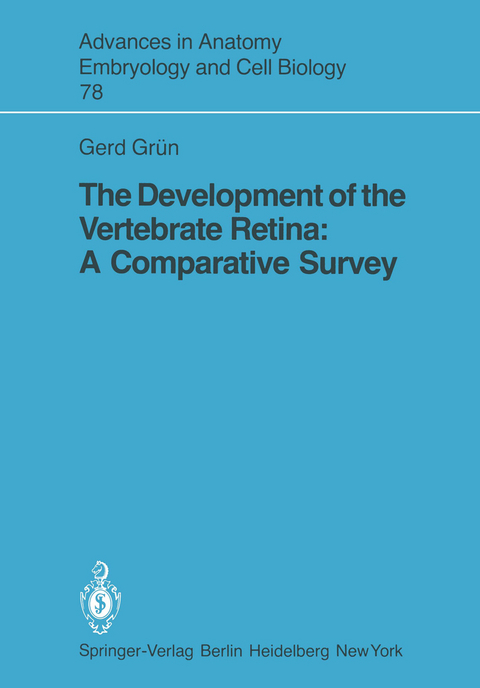
The Development of the Vertebrate Retina
Springer Berlin (Verlag)
978-3-540-11770-4 (ISBN)
1 Introduction.- 2 Temporal Patterns and Correlations.- 2.1 Differentiation of the Retina in Tilapia leucosticta.- 2.2 Differentiation of the Retina in Xenopus laevis.- 2.3 Differentiation of the Retina in the Chick, Gallus gallus domesticus.- 2.4 Differentiation of the Retina in the Mouse, Mus musculus.- 2.5 Differentiation of the Retina in the Rat, Rattus norvegicus.- 2.6 Differentiation of the Retina in Man, Homo sapiens.- 2.7 The Phases of Differentiation.- 2.8 Temporal Sequences.- 3 Specific Differentiation.- 3.1 Receptor Cell Inner Segment Formation.- 3.2 Receptor Cell Outer Segment Formation.- 3.3 Receptor Cell Terminal Formation.- 3.4 Formation of Functional Sites in the Inner Plexiform Layer.- 3.5 Neurochemical Differentiation.- 3.6 Development of Retinomotor Response.- 3.7 Functional Development of the Ganglion Cells.- 3.8 Development of the Electroretinogram.- 4 Development of the Retina by Differentiation of Single Cells.- 4.1 In Vitro Development of the Retina.- 4.2 Intracellular Differentiation.- 4.3 Ganglion Cell.- 4.4 Inner Plexiform Layer.- 4.5 Amacrine Cell.- 4.6 Bipolar Cell.- 4.7 Horizontal Cell.- 4.8 Receptor Cell.- 5 Differentiation at Tissue Level.- 5.1 Proliferation.- 5.2 Layering and General Differentiation.- 5.3 Specific Differentiation.- 5.4 Neurochemical Differentiation.- 5.5 Differentiation of Specific Activity.- 5.6 Miscellaneous.- 6 Summary.- References.
| Erscheint lt. Verlag | 8.10.1982 |
|---|---|
| Reihe/Serie | Advances in Anatomy, Embryology and Cell Biology |
| Zusatzinfo | VIII, 88 p. 9 illus. |
| Verlagsort | Berlin |
| Sprache | englisch |
| Maße | 170 x 244 mm |
| Gewicht | 215 g |
| Themenwelt | Studium ► 1. Studienabschnitt (Vorklinik) ► Anatomie / Neuroanatomie |
| Schlagworte | Cell • central nervous system • Development • Membrane • Metabolism • Migration • nervous system • Netzhaut • retina • tissue • Vertebrates • Wirbeltiere • Wirbeltiere / Vertebraten |
| ISBN-10 | 3-540-11770-9 / 3540117709 |
| ISBN-13 | 978-3-540-11770-4 / 9783540117704 |
| Zustand | Neuware |
| Haben Sie eine Frage zum Produkt? |
aus dem Bereich


